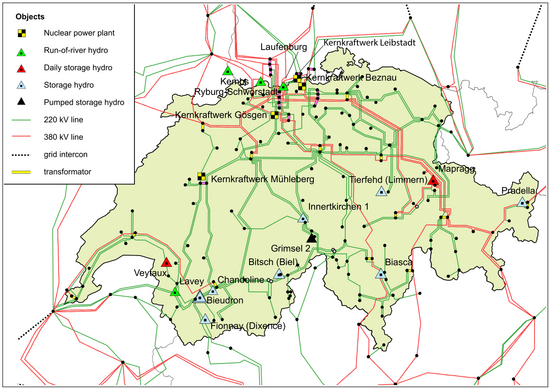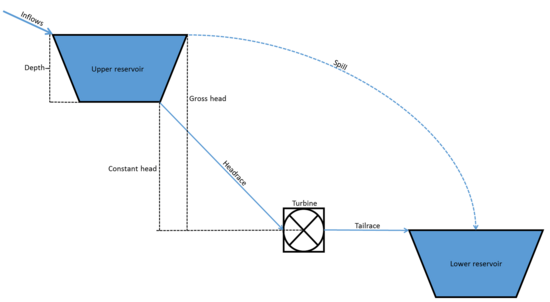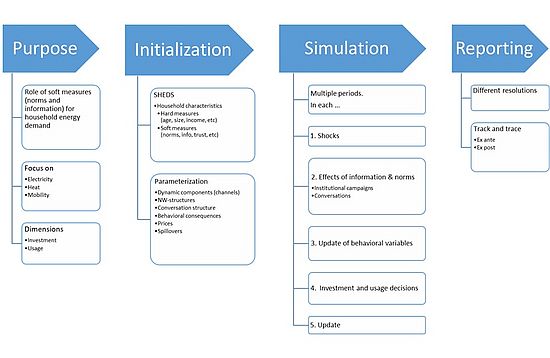One major research focus of the FoNEW team is conducting quantitative research on applied energy topics. To this regard a set of models and modeling approaches are used. On this page we will provide a short overview on the models used and the respective papers describing the modeling details as well as datasets and codes available for download.
The FoNEW team is furthermore involved in the SCCERJoint Activity Scenarios and Modelling (JASM) aiming to provide a set of robust scenarios for the realization of the Swiss Energy Strategy 2050. The modeling groups of the 8 Swiss Competence Centers for Energy Research (SCCER) work together and bring in their respective experience in the field of electricity generation technologies, buildings, mobility, industry, grids, biomass, storage and economy. Details can be found here
Swissmod
Model Description
Swissmod is a numerical model of the of the Swiss electricity market. It covers the Swiss high voltage transmission network (220 and 380kV) as well as a detailed representation of the Swiss hydropower structure. The latter includes specific characteristics of run-of-river, yearly storage and pumped storage power plants and their hydraulic coupling via the Swiss river and water stream system. Hydropower stations are modeled on a plant-by-plant basis in Swissmod. In total, 400 hydro stations are modelled in detail, representing around 96 % of Swiss hydro production. Each model-run simulates one year in hourly time resolution. The model framework has been tailored to allow for an in-depth analysis of future scenarios of the Swiss electricity market and its influencing factors.
Model Description Papers
- Schlecht, I., Weigt, H. (2015)
Swissmod - A Model of the Swiss Electricity Market
Working Papers 2014/04, Faculty of Business and Economics - University of Basel

Datasets and Codes
Data used in the Swiss System Adequacy studies is available on the SFOE webpage (Link)
Price Scenarios up to 2030 used in
Schillinger, M., Weigt, H., Barry, M., & Schumann, R. (2017) "Hydropower Operation in a Changing Market Environment - A Swiss Case Study"
are available as Excel (Link)
Price Scenarios up to 2050 used in
Schlecht, I., & Weigt, H. (2015) "Linking Europe: the role of the Swiss electricity transmission grid until 2050"
are available as Excel (to be added)
Hydro Power Plant Modeling
Model Description
As hydropower plays a central role within the Swiss electricity system providing about 60% of electricity supply the FoNEW team developed a modular power plant model. The model can be tailored to specific plant characteristics to represent real world stations and cascades. Furthermore, the underlying hydro database of Swissmod allows to define generic plant types. Those enable generic market assessments that are representative for the overall Swiss hydro sector. The model covers hydrologic inflow structures, storage and flow structures, turbine and pump characteristics and outflow constraints. It can be designed for single plant structures as well as connected cascaded plant structures.
Model Description Papers
- Schillinger, M., Weigt, H., Barry, M., & Schumann, R. (2017)
Hydropower Operation in a Changing Market Environment - A Swiss Case Study
SCCER CREST Working Paper WP3 - 2017/07

Datasets and Codes
Price Scenarios up to 2030 used in
Schillinger, M., Weigt, H., Barry, M., & Schumann, R. (2017) "Hydropower Operation in a Changing Market Environment - A Swiss Case Study"
to perform specific hydro revenue estimates
are available as Excel (Link)
Agent Based Energy Model
Model Description
The energy and environmental economics teams at the University of Basel developed an agent-based model of energy related behavior of different household types. The main purpose of the model is the investigation of the interactions stemming from information diffusion and the formation of social norms across households and its interplay with classical monetary incentive structures. The agent-based model is designed to account for the relevant decision aspects for investments and usage of energy applications of (Swiss) households and the potential interaction among households. Three separate agent-based models are developed for electricity, heat, and mobility. The three models follow the same overall structure and differ in their investment and usage variables. Each model starts with the initialization and parameterization of the agent population (households and/or individuals) for which the empirical data of SHEDS is utilized. The initialization is performed once, so that it does not change in the following simulation, that is, it represents the starting endowment of the households. The simulation determines the respective agent behavior from period to period. An arbitrary number of iterations can be simulated, where one iteration corresponds to one year. After the simulation, the results are aggregated and reported in different resolutions.
Model Description Papers
- tba
General Model and Data related Publications
- Abrell J., Eser P., Garrison J., Savelsberg J., & Weigt H. (2019)
Integrating economic and engineering models for future electricity market evaluation: A Swiss case study
Energy Strategy Reviews, 25 - Wiese et al (2019)
Open Power System Data – Frictionless data for electricity system modelling
Applied Energy, 236 - Pfenninger et al (2018)
Opening the black box of energy modelling: Strategies and lessons learned
Energy Strategy Reviews, 19

